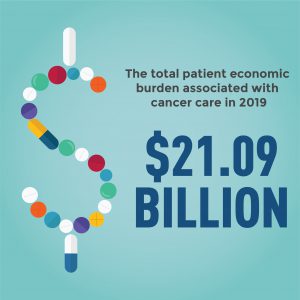The Cost of Cancer
Posted on byA Conversation With Some of the Authors of the Annual Report to the Nation on the Status of Cancer Part 2

Florence Tangka, PhD, Centers for Disease Control and Prevention
Jane Henley, MSPH, Centers for Disease Control and Prevention
Robin Yabroff, PhD, American Cancer Society
Jingxuan Zhao, MPH, American Cancer Society
Angela Mariotto, PhD, National Cancer Institute
A cancer diagnosis can affect life in many ways, both for people with cancer and for their families. In addition to the many physical and emotional challenges, many people worry about how they will pay for treatment or what will happen if they aren’t able to work or need to change how they work. Recognizing these costs for individuals and for our society is an important part of understanding the true burden of cancer.
We sat down with some of the authors of the recently released Annual Report to the Nation on the Status of Cancer Part 2 to answer a few questions about the report.
What kinds of expenses do people often have to pay for cancer care?
Out-of-pocket costs are expenses that cancer survivors and their families pay for health care. This care includes prescription drugs and medical services, such as provider and outpatient visits, emergency room visits, and hospital inpatient stays. For cancer survivors with health insurance coverage, out-of-pocket cost is their share of the cost that is not covered by insurance, such as copays, deductibles, and coinsurance. Cancer survivors without health insurance or with limited coverage may be responsible for the entire cost of care.
The economic burden to people with cancer is more than out-of-pocket costs. It also includes the time spent receiving medical care that could have been spent on a person’s normal everyday activities. This part of the economic burden of cancer is called patient time cost.
How do you estimate the time cost of cancer care?
The time cost of cancer care (also called the opportunity cost) is the value of the time that cancer survivors spend traveling to and from care, waiting for care, and receiving care. It represents time not spent with friends and family, at work, or on leisure activities. Patient time costs are estimated by adding up the hours that a person with cancer usually spends on health care and multiplying it by the hourly value of patient time. The median wage rate for an adult is often used to represent this hourly value. Time costs can be substantial and can be an additional economic burden for cancer survivors and their families.
This year’s annual report focused on the economic burden of cancer. What are the main findings?
We found that the economic burden associated with cancer care in the United States is substantial, both nationally and for individual cancer survivors. In 2019, the national patient economic burden associated with cancer care was estimated to be $21.09 billion. This estimate includes patient out-of-pocket costs of $16.22 billion and patient time costs of $4.87 billion.
We also found that the cost varied by age, stage at diagnosis, and phase of care. For example, out-of-pocket costs per person were generally higher among adult cancer survivors aged 18 to 64 than among those 65 or older.
Among adults 65 or older who had Medicare coverage, out-of-pocket costs were generally higher for those diagnosed with advanced cancer than early-stage disease.
On average, adult cancer survivors experienced about $300 in time costs because of cancer care each year. This cost was higher among cancer survivors aged 18 to 64 than among those 65 or older. It was also higher among adults who had been diagnosed in the last 2 years compared to those diagnosed more than 2 years ago.
Were there differences in patient economic burden by cancer type or other factors?
We found major differences in the pattern and magnitude of patient out-of-pocket costs depending on where cancer was found in the body. In 2019, national out-of-pocket costs were highest for the four most common cancers:
- Female breast cancer ($3.14 billion)
- Prostate cancer ($2.26 billion)
- Colorectal cancer ($1.15 billion)
- Lung cancers ($1.35 billion)
In addition, out-of-pocket costs per person for medical services were highest in the initial and end-of life phases of care for acute myeloid leukemia and brain cancer and in the continuing phase for myeloma, pancreatic cancer, and acute myeloid leukemia.
Out-of-pocket costs for prescription medications were highest in the initial, continuing, and end-of-life phases of care for chronic myeloid leukemia and myeloma.
Annual national patient time costs in 2019 were $1.11 billion for female breast cancer and $1.04 billion for prostate cancer. Breast and prostate cancers accounted for almost half of national patient time costs, reflecting the prevalence of these cancers.
Why are these findings important?
In addition to sickness and death from cancer and the cost of cancer treatment paid by insurers, out-of-pocket and patient time costs are other ways to measure the enormous economic burden of cancer. These high costs make cancer a public health priority.
Estimates of patient out-of-pocket and time costs can also guide discussions between health care providers and patients about expected costs of treatment, which is an important element of high-quality care.
Is there a call to action or next steps for what can be done with the information in this report?
This report highlights the importance of including patient out-of-pocket and time costs when providers and patients make decisions about cancer treatment.
In addition, limited research has been done on how cancer diagnoses affect the family members and other informal caregivers of cancer patients. These unpaid caregivers often go with patients to medical appointments and provide care in the home. The costs associated with this care is an important topic for future research.
Posted on by

